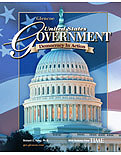
U. S. Government: Democracy In ActionChapter 13: Constitutional FreedomsChapter OverviewsThe Constitution guarantees all citizens of the United States certain rights. These rights include such liberties as freedom of speech and freedom of religion. Chapter 13 explores these rights as well as others, and discusses how they are protected under the Constitution. Section 1 deals with the Bill of Rights and the constitutional freedoms and protections that it provides. The Constitution is often called a living document because through amendments and interpretation, the Constitution changes along with society. Key terms such as human rights and incorporation are introduced and explain how people are protected from all levels of government. Section 2 discusses freedom of religion and how interpretation of this freedom has sparked many debates. In the middle of these debates stand two clauses—the establishment clause and the free exercise clause. Landmark cases such as Everson v. Board of Education and the flag salute cases helped shape policy through court interpretation of the law. Section 3 introduces freedom of speech and what this means to United States citizens. As citizens we often take this right for granted. Many people believe in freedom of speech until alternate ideas differ from popular opinion. The First Amendment protects this right and allows for diversity of opinion. Section 4 deals with freedom of the press and the debate over this First Amendment right. Freedom of the press is considered to be similar to freedom of speech and oftentimes is protected as the same. However, a few cases throughout history have challenged this notion. Key terms such as prior restraint, gag order, and shield laws put this debate in perspective. Section 5 introduces freedom of assembly and explains how it is protected under the Constitution. Without freedom of assembly there could be no political parties or special interest groups to influence government. Freedom of assembly allows United States citizens to peaceably assemble and make views public to government officials. Assembly could include petitions, letters, lobbying, and marching with signs. |  |















